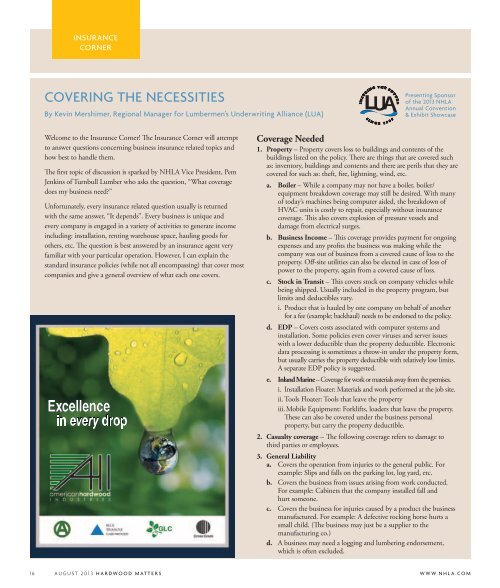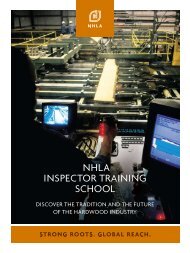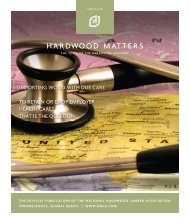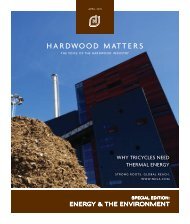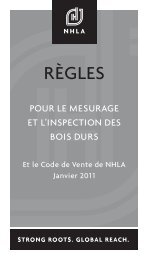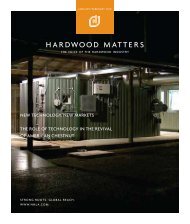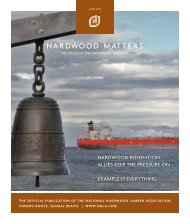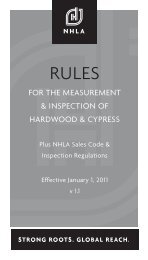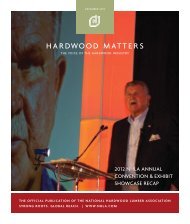hm - Aug13 - cover.indd - National Hardwood Lumber Association
hm - Aug13 - cover.indd - National Hardwood Lumber Association
hm - Aug13 - cover.indd - National Hardwood Lumber Association
- No tags were found...
You also want an ePaper? Increase the reach of your titles
YUMPU automatically turns print PDFs into web optimized ePapers that Google loves.
INSURANCE<br />
CORNER<br />
COVERING THE NECESSITIES<br />
By Kevin Mershimer, Regional Manager for <strong>Lumber</strong>men’s Underwriting Alliance (LUA)<br />
Presenting Sponsor<br />
of the 2013 NHLA<br />
Annual Convention<br />
& Exhibit Showcase<br />
Welcome to the Insurance Corner! The Insurance Corner will attempt<br />
to answer questions concerning business insurance related topics and<br />
how best to handle them.<br />
The first topic of discussion is sparked by NHLA Vice President, Pem<br />
Jenkins of Turnbull <strong>Lumber</strong> who asks the question, “What <strong>cover</strong>age<br />
does my business need”<br />
Unfortunately, every insurance related question usually is returned<br />
with the same answer, “It depends”. Every business is unique and<br />
every company is engaged in a variety of activities to generate income<br />
including: installation, renting warehouse space, hauling goods for<br />
others, etc. The question is best answered by an insurance agent very<br />
familiar with your particular operation. However, I can explain the<br />
standard insurance policies (while not all encompassing) that <strong>cover</strong> most<br />
companies and give a general overview of what each one <strong>cover</strong>s.<br />
Excellence<br />
in every drop<br />
Coverage Needed<br />
1. Property – Property <strong>cover</strong>s loss to buildings and contents of the<br />
buildings listed on the policy. There are things that are <strong>cover</strong>ed such<br />
as: inventory, buildings and contents and there are perils that they are<br />
<strong>cover</strong>ed for such as: theft, fire, lightning, wind, etc.<br />
a. Boiler – While a company may not have a boiler, boiler/<br />
equipment breakdown <strong>cover</strong>age may still be desired. With many<br />
of today’s machines being computer aided, the breakdown of<br />
HVAC units is costly to repair, especially without insurance<br />
<strong>cover</strong>age. This also <strong>cover</strong>s explosion of pressure vessels and<br />
damage from electrical surges.<br />
b. Business Income – This <strong>cover</strong>age provides payment for ongoing<br />
expenses and any profits the business was making while the<br />
company was out of business from a <strong>cover</strong>ed cause of loss to the<br />
property. Off-site utilities can also be elected in case of loss of<br />
power to the property, again from a <strong>cover</strong>ed cause of loss.<br />
c. Stock in Transit – This <strong>cover</strong>s stock on company vehicles while<br />
being shipped. Usually included in the property program, but<br />
limits and deductibles vary.<br />
i. Product that is hauled by one company on behalf of another<br />
for a fee (example; backhaul) needs to be endorsed to the policy.<br />
d. EDP – Covers costs associated with computer systems and<br />
installation. Some policies even <strong>cover</strong> viruses and server issues<br />
with a lower deductible than the property deductible. Electronic<br />
data processing is sometimes a throw-in under the property form,<br />
but usually carries the property deductible with relatively low limits.<br />
A separate EDP policy is suggested.<br />
e. Inland Marine – Coverage for work or materials away from the premises.<br />
i. Installation Floater: Materials and work performed at the job site.<br />
ii. Tools Floater: Tools that leave the property<br />
iii. Mobile Equipment: Forklifts, loaders that leave the property.<br />
These can also be <strong>cover</strong>ed under the business personal<br />
property, but carry the property deductible.<br />
2. Casualty <strong>cover</strong>age – The following <strong>cover</strong>age refers to damage to<br />
third parties or employees.<br />
3. General Liability<br />
a. Covers the operation from injuries to the general public. For<br />
example: Slips and falls on the parking lot, log yard, etc.<br />
b. Covers the business from issues arising from work conducted.<br />
For example: Cabinets that the company installed fall and<br />
hurt someone.<br />
c. Covers the business for injuries caused by a product the business<br />
manufactured. For example: A defective rocking horse hurts a<br />
small child. (The business may just be a supplier to the<br />
manufacturing co.)<br />
d. A business may need a logging and lumbering endorsement,<br />
which is often excluded.<br />
16 AUGUST 2013 HARDWOOD MATTERS WWW.NHLA.COM


